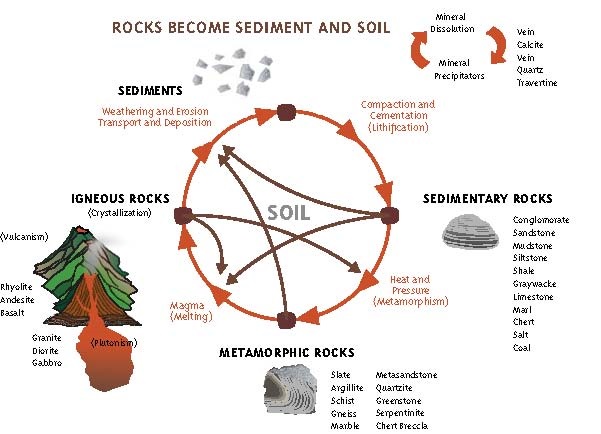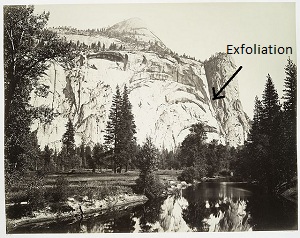Where does soil come from?
Weathering is the breakdown of rocks and minerals into soils. Rocks are broken into three major groups: sedimentary, igneous, and metamorphic. The rock cycle illustrates how these different types of rocks form. An animated version of the rock cycle can be found at the British Geological Society website.

This is an image of the process of rocks becoming sediment and soil.
Different Types of Weathering
The University of Kentucky website has some amazing animations of physical and chemical weathering surfaces common in the different regions, from warm and wet to dry.
Physical Weathering
Physical weathering is the breaking of rocks into smaller pieces. This can happen through exfoliation, freeze-thaw cycles, abrasion, root expansion, and wet-dry cycles.

Exfoliation at Yosemite National Park.C.E. Watkins. Yosemite Views. Image 435041. New York Public Library
Exfoliation: When temperature of rocks rapidly changes that can expand or crack rocks. This especially happens with granitic rocks as they were cooling, like at Yosemite National Park.
Freeze-thaw: When water freezes, it expands. If moisture seeps into cracks before winter, it can then freeze, driving the rocks apart.
Abrasion: When the wind blows, it can pick up sand and silt, and literally sandblast rocks into pieces.
Root Expansion: Like freeze thaw, roots grow bigger every year. These roots can drive the roots apart.
Chemical Weathering
Chemicals react in the environment all the time, and these cause chemical weathering. Major chemical reactions include carbonation, dissolution, hydration, hydrolysis, and oxidation-reduction reaction. All of these reactions have water involved with them.

Example of Limestone Dissolution in the Cathedral Room at Florida Caverns State Park. Credit: State Archives of Florida, Florida Memory, Mark Ludlow.
Carbonation: When water reacts with carbon dioxide, it creates carbonic acid, which can dissolve softer rocks.
Dissolution: Limestone and rocks high in salt dissolve when exposed to water. The water carries away the ions.
Hydrolysis: Minerals in the rock react with water and surrounding acids. The hydrogen atoms replace other cations. Feldspar hydrate to clay.
Oxidation-Reduction: Water and rock particles react with oxygen. This causes the minerals and materials to rust and turn red.
If the area is hot and humid, chemical weathering is more prevalent. If it is drier, physical weathering is more predominant.
Related Link
Geology Kitchen: Weathering YouTube video with Devin Denny that shows hands on activities and demonstrations that can be done with weathering.
Go back to Soil Formation
Go back to Mineralogy
Go back to Soil Physical Properties



